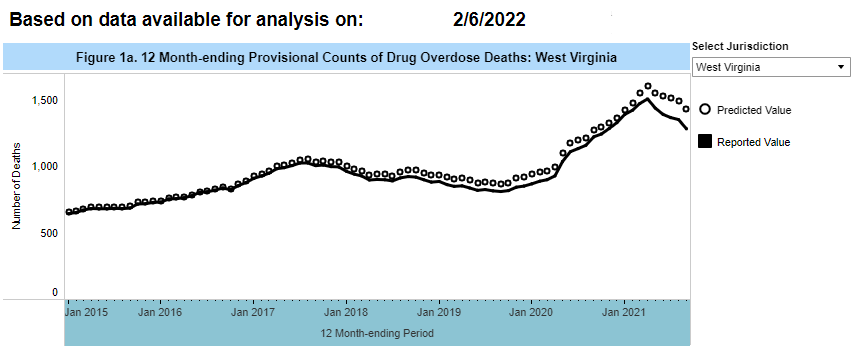The West Virginia Department of Health and Human Resources’ Office of Drug Control Policy (ODCP) has reported an improvement in the number of monthly overdose deaths from April 2021 through September 2021. This downward trend aligns with provisional data released by the U.S. Centers for Disease Control and Prevention, which indicates West Virginia’s decline in monthly overdose deaths is better than the national average and neighboring states.
The provisional data can be found at https://www.cdc.gov/nchs/nvss/vsrr/drug-overdose-data.htm. Select the header titled 12 Month-ending Provisional Number of Drug Overdose Deaths and select West Virginia under jurisdiction.

For example, the study shows two of West Virginia’s counties with typically the highest overdose death rates, Cabell and Kanawha counties, decreased deaths from April to September 2021. Specific data can be found by selecting the state and the county in the drop-down menu under the header titled Provisional Drug Overdose Deaths by County, 12 month period ending July, 2021 https://www.cdc.gov/nchs/nvss/vsrr/prov-county-drug-overdose.htm.
“As in many other states, West Virginia experienced an increase in overdose deaths during the COVID-19 pandemic as people were isolated and unable to connect with others,” said Dr. Matthew Christiansen, ODCP Director. “The significant drop in overdose deaths in recent months is a testament to the leadership of Governor Jim Justice and the hard work and collaboration across DHHR bureaus to provide and expand innovative, high quality, evidence-based addiction and mental care to residents.”
In 2021, a number of measures were implemented to address the overdose epidemic. DHHR distributed record numbers of naloxone to high risk individuals, continued the expansion of treatment and recovery services, licensed new syringe service programs, built a network of ODCP Regional Coordinators in the hardest hit counties, launched new stigma campaigns, and continued to move the treatment system towards quality outcomes.
“While no overdoses are acceptable, we are encouraged by this data and will continue our efforts to end West Virginia’s substance use epidemic,” added Dr. Christiansen.
Resources include HELP4WV, which offers 24/7 confidential support and resource referrals through call, text, and chat lines. HELP4WV also offers a Children’s Crisis and Referral line. Residents may call HELP4WV at 844-HELP4WV, text at 844-435-7498, or chat at www.help4wv.com.
Additionally, another service, Help304 offers social and emotional counseling through its professional crisis counselors. People may contact Help304 at 1-877-HELP304, text at 1-877-435-7304, or chat at http://help304.com.
The National Suicide Prevention Line, which provides 24/7 free and confidential support, prevention, and crisis resources, is available at 800-273-TALK (8255).
For more information on West Virginia’s efforts to combat the substance use epidemic, visit https://dhhr.wv.gov/office-of-drug-control-policy/Pages/default.aspx. To view the ODCP dashboard, visit https://dhhr.wv.gov/office-of-drug-control-policy/datadashboard/Pages/default.aspx.